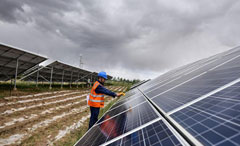Experts eye clean energy future for China plateau province
2017-08-24
Xinhua
XINING — Northwest China’s Qinghai province could become the first region in China to run entirely on clean energy by 2050, experts have said.
By 2050, the installed capacity of green energy in Qinghai could reach 400 million kilowatts, and its annual electricity generation could surpass 800 billion kilowatt hours, said Lu Qiang, academician with Chinese Academy of Sciences, at a high-profile green energy forum in Qinghai.
“By then, it could completely remove reliance on fossil energy and run solely on stable, safe and sustainable green energy sources,” Lu said.
From June 17 to midnight June 23, Qinghai ran entirely on renewable energy, using wind, solar and hydro power.
During the period, hydro power plants supplied 72.3 percent of the electricity, with new energy such as wind and solar supplying the remainder.
Home to the source of China’s major rivers, including the Yellow, Yangtze and Lancang rivers, Qinghai has strong hydropower and solar supplies, and is home to 5.8 million people.
By May this year, the Qinghai power grid had an installed capacity of 23.4 million kilowatts, about 82.8 percent coming from hydro, solar and wind power.
The Qaidam Basin in Qinghai is one of China’s 13 recycling economy pilot zones.
“Qinghai has an organic industry chain of power generation. It also has diverse transmission paths if it wants to send power to other regions. Qinghai has stronger competitiveness than other regions to develop green energy,” said Jin Yong, an academician of the Chinese Academy of Engineering.
During the 12th five-year plan period (2011-2015), China’s energy consumption per unit of GDP dropped by 18.2 percent, said Ren Shuben, head of environment resources at the National Development and Reform Commission.
“Now is a good time to give a strong push to green energy and the recycling economy to change energy consumption and achieve high-efficiency energy use,” he said.
Lu said Qinghai needed to tackle problems of instability in green energy and develop a smart grid where hydropower, solar, wind and power storage facilities could function together organically.
According to the provincial 13th five-year plan, Qinghai will expand its solar and wind capacity to 35 million kilowatts by 2020 and supply 110 billion kilowatt hours of clean electricity every year to central and eastern parts of China, without burning 50 million tons of coal.
China’s enthusiasm for clean energy is pushing the global transition toward a low-carbon future with plans to invest 2.5 trillion yuan ($370 billion) in renewable energy by 2020, creating more than 13 million jobs, according to the National Energy Administration.

